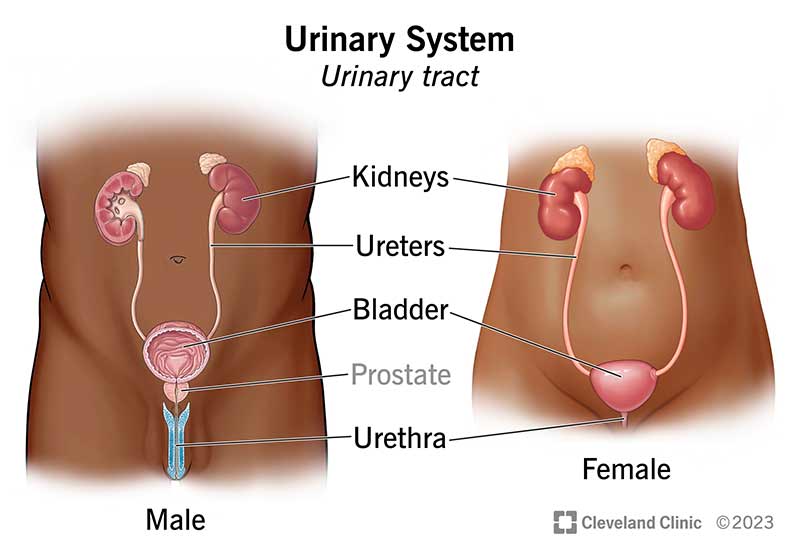Have you ever felt a burning sensation when you pee? Or a sudden, strong urge to urinate—only to release just a few drops? If yes, you may have experienced a Urinary Tract Infection (UTI). They’re uncomfortable, often misunderstood, but luckily, treatable.
UTIs are very common, especially in women. In fact, over 50% of women will get at least one UTI in their lifetime. But they don’t discriminate—men and children can get them too. In this guide we’ll talk about what causes UTIs, how to treat and prevent them and bust one of the biggest myths concerning UTI’s.
What Is a UTI?
A UTI happens when bacteria, usually from the skin or rectum, travel up the urethra and infect the urinary tract. The urinary tract includes the kidneys, ureters, bladder, and urethra. Most UTIs affect the bladder, but if left untreated, the infection can spread to the kidneys—which can be serious.

UTIs are typically classified based on where the infection occurs:
- Cystitis – infection of the bladder
- Urethritis – infection of the urethra
- Pyelonephritis – infection of the kidneys
Who is at risk?
UTIs affect people of all ages and sexes, but women are affected the most because their urethra is shorter, making it easier for bacteria to enter the bladder.
You’re more likely to get a UTI if you:
- Don’t drink enough water
- Hold your pee often
- Are sexually active
- Use certain types of birth control (like diaphragms)
- Are pregnant or menopausal
- Have diabetes or a weakened immune system
Symptoms of a Urinary Tract Infection

Here are the most common symptoms. Some are mild, while others might require urgent attention:
- A burning feeling when you urinate
- Frequent or urgent need to pee
- Cloudy or strong-smelling urine
- Pelvic pain or pressure in the lower belly
- Blood in the urine (in some cases)
UTI RED FLAGS- WHEN TO SEE A DOCTOR
If the infection travels to the kidneys, you may also experience:
- Fever and chills
- Nausea or vomiting
- Pain in the back or sideSymptoms last more than 1–2 days
- You develop a fever, chills, or back pain
- You keep getting UTIs often
- You’re pregnant or have a chronic illness
- Acute Kidney Injury (Can present as reduced urine volume, Leg Swelling, facial puffiness )
- can progress to chronic Kidney diseases needing dialysis if not treated well
- Delirium secondary to a UTI- Elderly People may even present with a change in behavior, have delusion and hallucinations when they have a UTI.
Diagnosing a urinary tract infection
Doctors start by asking about your symptoms—burning when you pee, going more often than usual, or feeling like you can’t wait. If those sound familiar, they’ll likely suspect a urinary tract infection.
Next, they test a sample of your urine. A quick dipstick test checks for signs of infection like white blood cells, nitrites, or blood.
To confirm the diagnosis, they often send the urine to the lab for microscopy, culture, and sensitivity (Urine R/E and Urine C/S). This helps them pinpoint the exact bacteria causing the infection and choose the right antibiotic.
If you keep getting UTIs or have unusual symptoms, your doctor may order an ultrasound or CT scan to check for deeper issues in your urinary tract.
Medical Treatment
Most UTIs are treated with antibiotics, which are prescribed after a quick test. Symptoms usually improve within a few days of starting medication, but it’s important to finish all your antibiotics, even if you feel better.
For mild UTIs, a short course of oral antibiotics usually clears things up in a few days. If the infection is severe or has reached the kidneys, you might need stronger medication or even IV antibiotics.
The type of antibiotic used varies based on the antibiotic resistance profile in your town. Your doctor may start with an antibiotic that is effective against the bacteria that commonly cause UTI’S then switch to a more specific one when your urine results are ready.
Pain relief (like paracetamol) and drinking lots of water can also help flush out the bacteria faster.
The Cranberry Juice myth
We can’t discuss Urinary Tract Infections without discussing one of the biggest myths about treating UTI’s.
Cranberries may help prevent UTIs by stopping bacteria from sticking to the bladder wall—but they don’t cure active infections.
Cranberries contain compounds like proanthocyanidins that may prevent certain bacteria—particularly E. coli—from sticking to the lining of the urinary tract. Drinking cranberry juice isn’t a guaranteed way to treat or prevent UTIs.
Most commercial cranberry juices are also loaded with sugar.
It would be dangerous to rely solely on cranberry juice instead of seeing a healthcare provider as this may delay proper diagnosis and treatment.
How to Prevent a Urinary Tract Infection
Urinary tract infections (UTIs) are not only common but also preventable with a few simple lifestyle habits. Here’s how to stay one step ahead of UTIs.
Drink plenty of water to flush out bacteria
- Don’t hold in your pee
- Wipe front to back (for people women)
- Pee after sex to help wash out any bacteria
- Avoid scented soaps, sprays, or douches in the genital area
- Wear breathable, cotton underwear and change it daily
Final Thoughts
UTIs are common and annoying—but with a bit of knowledge and care, they can be prevented and treated effectively.
If you’re experiencing symptoms, don’t wait—see a doctor . No need to wait in long endless lines- you can see a doctor now within the next 5mins.


Leave a Reply